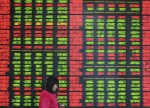
- All Instrument Types
- Indices
- Equities
- ETFs
- Funds
- Commodities
- Currencies
- Crypto
- Bonds
- Certificates
Please try another search

4 Reasons Why Investors Love Passive ETFs

While the ETF industry is growing by leaps and bounds, investors’ inclination toward passive ETFs is quite remarkable. There are about 1836 non-leveraged ETFs listed on U.S. indexes with an average market-cap of $3.29 trillion and average expense ratio of 0.57%, as per xtf.com.
Among them, 900 are passively managed, followed by 740 ETFs following the enhanced strategy and 196 active funds. It is being noted that though the investment objective of active funds looks more promising, the gush of money is flowing into passive investment vehicles, as per John “Mac” McQuown, co-founder of Dimensional Fund Advisors, (ab the $550bn investment group), as quoted on Financial Times.
Inside the Increasing Interest in Passive Funds
Low Expense Ratio
The outperformance was attributed to the strong performance and a low expense ratio. Expense ratios of active funds are higher than passive funds. Low expense ratio has been instrumental lately in amassing investors’ assets. Most ETF issuers have embarked upon the fee war (read: BlackRock Slashes Fees, ETF Price War Intensifies).
BlackRock has been pretty proactive in slashing expense ratios for several products in a year. It is being said that the company took the step to give tough competition to other low-cost players like Vanguard and Schwab. As a result, the company has been witnessing strong inflows in recent quarters (read: Solid ETF Asset Inflows Boost BlackRock Earnings).
For example, BlackRock lowered fees for its S&P 500 tracking ETF, iShares Core S&P 500 IVV, from 0.07% to 0.04%. The fee cut made IVV less expensive than another popular ETF, SPDR S&P 500 ETF (AX:SPY) , in its domain. The fund charges 9 bps in fees. However, yet another S&P 500-based ETF, Vanguard S&P 500 ETF VOO, also charges 4 bps in fees (read: Buy These ETFs as BlackRock Cuts Fees).
The Financial Times article went on to explain that “BlackRock and Vanguard, the two biggest players in the passive investing world, manage nearly $11tn between them, having taken in nearly $600bn this year — the vast majority of it in ETFs and index-tracking mutual funds.”
Bull Market
Since Trump’s win last November, Wall Street has been buoyant barring some occasional slips. The global economy has been prospering, giving ways to a broad-based bull market, in which most market-linked products are trending. This in turn marred the appeal for active ETFs.
Some of the top-performing active ETFs in the last one-year frame were ARK Web x.0 ETF ARKW (up 70.9%) followed by ARK Innovation ETF (KW:ARKK) (up 68.8%) and ARK Industrial Innovation ETF ARKQ (up 56.5%).
And the top-performing passive ETFs were Guggenheim China Technology ETF CQQQ (up 70.1%), Global X Lithium & Battery Tech ETF (AX:LIT) (up 66.1%), VanEck Vectors Rare Earth/Strat Metals ETF REMX (up 61.2%), Global X Robotics & Artfcl Intllgnc ETF BOTZ (up 58.4%) and iShares PHLX Semiconductor ETF SOXX (up 48.7%).
In a year, Europe-based active fund First Trust RiverFront Dynamic Europe ETF RFEU (which charges 83 bps in fees) has gained 25.5% (as of Nov 17) while the passive fund Vanguard FTSE Europe ETF VGK (which charges 10 bps in fees) has added 25%.
If performances of passive ETFs are on par with (or even better than) the active ones, why will investors flock to active ETFs at higher charges?
Quantitative Strategies of Passive ETFs
Several passive ETFs are factor-based and use quantitative strategies. In line with the article published on Financial Times, we also believe that such strategies make passive ETFs more active and position them better to pick the right stock.
Downside of Transparency in Active ETFs
One of the major drawbacks of actively managed ETFs is the obligation of the disclosure of daily portfolio holdings, which run the risk of enabling “front-running” of portfolio trades. This means that the revelation of stock holdings will give the issuer’s competitors or other investors a chance to cash in on advance information (read: Will Active ETFs Rule Ahead?).
Want key ETF info delivered straight to your inbox?
Zacks’ free Fund Newsletter will brief you on top news and analysis, as well as top-performing ETFs, each week. Get it free >>
SPDR-SP 500 TR (SPY (NYSE:SPY)): ETF Research Reports
GUGG-CHINA TEC (CQQQ): ETF Research Reports
ISHARS-PHLX SEM (SOXX): ETF Research Reports
ARK- WEB XO ETF (ARKW): ETF Research Reports
VANGD-SP5 ETF (VOO): ETF Research Reports
ISHARS-SP500 (IVV): ETF Research Reports
ARK-INNOVATION (ARKK): ETF Research Reports
GLBL-X LITHIUM (LIT): ETF Research Reports
VANGD-FTSE EUR (VGK): ETF Research Reports
ARK-INDUS INNOV (ARKQ): ETF Research Reports
VANECK-RAR ERTH (REMX): ETF Research Reports
FT-RF DYN-EUR (RFEU): ETF Research Reports
GLBL-X ROB&ART (BOTZ): ETF Research Reports
Original post
Zacks Investment Research
Related Articles

Walgreens Boots Alliance Inc. (NASDAQ:WBA) is on the brink of a significant transformation as it nears a deal with Sycamore Partners to become a private entity. The transaction,...

Using the Elliott Wave Principle (EWP), we have been successfully tracking the most likely path forward for the S&P 500 (SPX) over several months. Although there are many ways...

When looking for dividend stocks, high dividend yields are one important factor to consider. Even if a company’s dividend yield isn’t nearing double-digit percentages, finding...
Are you sure you want to block %USER_NAME%?
By doing so, you and %USER_NAME% will not be able to see any of each other's Investing.com's posts.
%USER_NAME% was successfully added to your Block List
Since you’ve just unblocked this person, you must wait 48 hours before renewing the block.
I feel that this comment is:
Thank You!
Your report has been sent to our moderators for review





Add a Comment
We encourage you to use comments to engage with other users, share your perspective and ask questions of authors and each other. However, in order to maintain the high level of discourse we’ve all come to value and expect, please keep the following criteria in mind:
Enrich the conversation, don’t trash it.
Stay focused and on track. Only post material that’s relevant to the topic being discussed.
Be respectful. Even negative opinions can be framed positively and diplomatically. Avoid profanity, slander or personal attacks directed at an author or another user. Racism, sexism and other forms of discrimination will not be tolerated.
Perpetrators of spam or abuse will be deleted from the site and prohibited from future registration at Investing.com’s discretion.